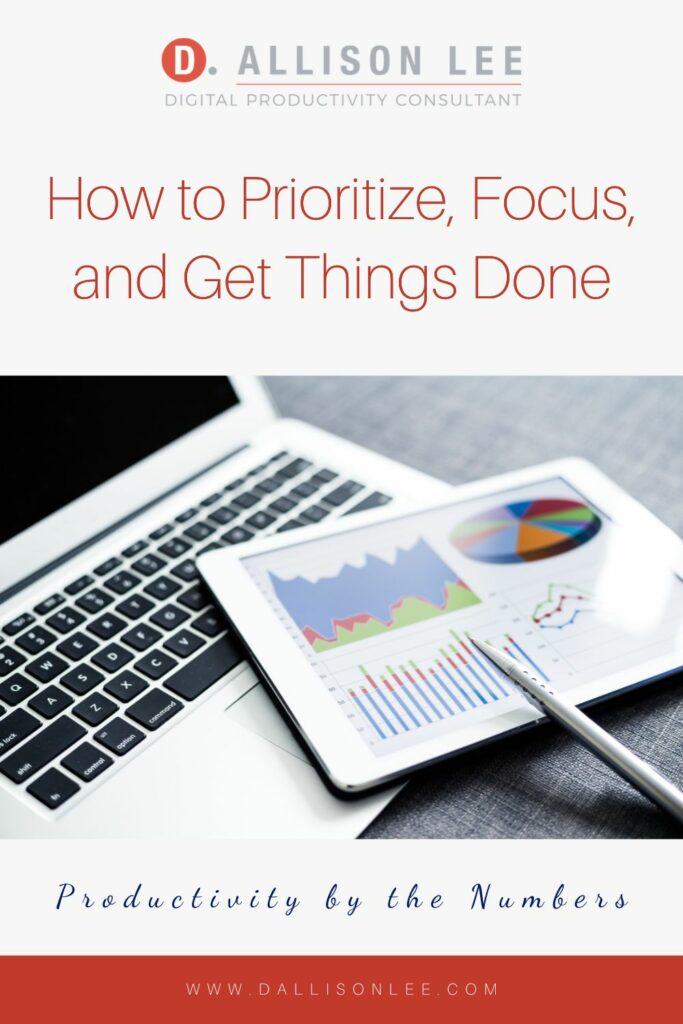Ever noticed that taking breaks can boost your productivity? It might seem counterintuitive but resting…

Productivity by the Numbers: How to Prioritize, Focus, and Get Things Done
Getting things done is often a balancing act of time, focused effort, and consistent action. The right productivity setup can make all the difference and can play a big role in finding that balance. Today’s post will explore the power of numbers and how the right ones can help you prioritize, focus, and boost your productivity. From the Pomodoro Technique to the 2-Minute Rule, using a numerical framework (or a set of them) can help you work more efficiently and effectively.
Keep reading to learn about some of the most successful productivity methods that involve numbers to help you find *your* unique productivity formula.
Numbers and Productivity: How to Prioritize Tasks
Before you begin working, it’s important to figure out the weight of each task. Which ones take priority? How do you decide which to-do’s should get your attention first? The Eisenhower Matrix and the Pareto Principle are two ways to find the answer.
The Eisenhower Matrix
This productivity tool is named after 5-Star Army General and the 34th President of the United States, Dwight D. Eisenhower, who was known to have the ability to make tough decisions. Though this productivity tool doesn’t have a number in it’s title, it does contain four quadrants (or categories) that can help you decide which tasks and projects take priority over others based on importance and urgency.
It’s easy to get caught up with being busy with everything that life and work will through at you. The Matrix will help you decide which tasks should get your attention so you can focus on the right things at the right time.
(no more winging it!)
This nice thing about the Eisenhower Matrix is that it’s simple to use. The four quadrants or boxes each have a specific label that helps guide your next step.
- Urgent + Important (do immediately — take action now)
- Important, Not Urgent (tackle these tasks at a later time – schedule them)
- Urgent, Not Important (you don’t have to do them — delegate instead)
- Not Urgent, Not Important (why are they on your list? — delete or use your reward)
 Click here to download the Eisenhower Matrix Evernote template.
Click here to download the Eisenhower Matrix Evernote template.
To start, scan your to-do list and then add each task to the appropriate category on the Matrix. Try a small number of tasks to begin (say 3-5 per quadrant and no more than 10) so that you don’t get overwhelmed.
Alright, so which tasks go in each box?
Let’s say one of your tasks is to publish a post on LinkedIn.
- You might put that in the “Urgent, Not Important” quadrant and delegate it to your social media manager.
- Or, it could go in the “Important, Not Urgent” box for you to block out some time to add the content to a social media scheduler like AgoraPulse or Buffer.
Maybe you have to create a slide deck for presentation you’re giving in one week.
That would likely go in the “Urgent + Important” box as the deadline is looming. If you have a virtual assistant who is filling in the copy on your slides for you to review (way to delegate!), the task might stay in the same quadrant but the action you need to take may be different than if you were starting it from scratch.
What about spending some time watching TikTok videos?
All eyes probably look toward “Not urgent, Not Important,” and with good reason .
But don’t hit delete just yet.
While watching fun videos isn’t urgent or important per se, watching them can bring a smile to your face and lighten up a tough day. So why not use it at your reward? Take some time to watch a couple of videos *after* you’ve completed your priority tasks (e.g., end of the work day). Win!
Productivity by the Numbers: How to Prioritize, Focus, and Get Things Done via @DAllisonLee #productivitytips Share on X80/20 Rule (Pareto Principle)
The Pareto Principle, also known as the 80/20 Rule, is a rule that states that 80% of outcomes come from 20% of the efforts or inputs. This principle was first observed by Italian economist Vilfredo Pareto in the late 19th century and has since been widely used in business and economics.
In simpler terms, it means that a small portion of your activities will likely lead to the majority of your results.
Examples:
- 20% of your tasks might take up 80% of your time
- 20% of your customers might generate 80% of your revenue
The concept behind the Pareto Principle (as it relates to getting things done) is that a small fraction of your to-do list, roughly 20%, will produce the bulk of your results, around 80%. The goal is to determine the tasks have the most impact for you (or your team), and to concentrate your efforts on those specific tasks to achieve the greatest outcome for the day.
So what small number of tasks are responsible for producing the majority of the results you want to see? Let’s look at an example.
Perhaps you’re a solopreneur with these 10 tasks that must be completed in 7 days:
- Sign up two new clients
- Organize and clear desk
- Attend virtual networking event
- Finish presentation slide deck
- Take digital course on time management
- Publish a new post on Instagram
- Complete a high-paying project
- Write and publish a blog post
- Reply to emails
- Gather tax documents
To apply the 80/20 rule, start by identifying the two tasks that will bring in the best results or have the highest impact.
Those two tasks could be:
- Getting two new clients
- Completing a high-paying project
Now that you’ve found your 2 small-but-big-impact tasks, you can focus your effort on completing them first. The remaining 8 tasks may still be important, but they might not have as significant an impact on your bottom line.
Okay, now over to you. Have a look at your task list or the to-do’s in your task management app. Which ones do you think would have the highest impact? Can you pinpoint 20% of your tasks that would give you 80% of the results you want?
Interesting to find out: Do the priority tasks from your Eisenhower Matrix match up with ones from your 80/20 results?
Save this post to your “Productivity” board
Boost Your Productivity: The Numbers That Help You Focus and Get Stuff Done
There are several numerical productivity methods that help you to stay on task and get stuff done. I’m sharing 5 of them today. To kick things off, let’s start with the …
1) 2-Minute Rule
This rule is awesome sauce! Why? Because you can use it to get a quick and easy win. Several, in fact. This rule states that if it takes only 2 minutes (or less) to complete, just do it. It’s as simple as that. At least, so says David Allen, author of “Getting Things Done: The Art of Stress-Free Productivity.” (affiliate link)
Not sure what things might take 2 minutes or less? This is where a time tracking worksheet or an app like Rescue Time. can help.
By tracking all the tasks you work on (planned and unplanned) throughout the course of a few days, you’ll get a good idea of how much time you spend on each one. Some things may be more intuitive and you can “just feel” how long they take. But just to be sure, set a timer to confirm.
Download: Get your free time tracking worksheet. Click here to get it.
Then make a list of things that you can do quickly and refer to it as needed (on hectic days, you’ll need a reminder).
Here are some of my 2-minute business tasks for inspiration:
- Put away a paper or digital file
- Wipe down my keyboard
- Dust my desk
- Add a task to my to-do list
- Make a note of the next step for an important project
- Send a quick response to text message (like “yes” or “no” or “I’ll have to get back to you _____ <insert timeframe>)*
- Scan a blog post
- Send an article to Evernote
- Snooze an email
- Schedule (not write) an email to be sent later
- Start an outline (for a blog post, digital course, white paper, email)
- Write bullet points for blog post introduction
- Type “INSERT PHOTO” in blog post outline instead of going to search for the image
- Unsubscribe from unwanted emails
*this is super quick when I use voice dictation and autocorrect behaves itself
And here are a few personal tasks from my own list:
- Make the bed
- Read an affirmation out loud
- Put laundry in the washer or dryer
- Put a dirty dish in the dishwasher
- Schedule a doctor’s appointment using the online portal (calling takes waaay longer)
- Wipe down a counter
- Push your chair in
- Brush your teeth
- Put junk mail in the trash or recycling bin
- Meditate or take a break
- Complete one Spanish lesson (using Duolingo)
- Listen to a podcast (like these on various topics or this one about productivity)
Remember, the 2-Minute Rule will make your future self smile and feel grateful that you took care of those quick things instead of letting them pile up. When they pile up, they become overwhelming and more difficult to complete.
2) 5-Minute Rule
At first glance, this might seem like a lengthier version of the 2-Minute Rule. Sure, you can stretch your 2 minutes to 5 to take care of some quick tasks. But, the 5-Minute Rule can really help you stop procrastination from taking hold.
(now that I think about it, so can the 2-Minute Rule — David Allen was really on to something!)
We all have those days when our motivation is non-existent or when a project just seems too big to even think about. That’s when you pull out your Eisenhower Matrix or go on a search for your small-but-mighty tasks.
Once you pick your priority to-do’s, tell yourself that all you need to do is put in 5 minutes. That’s it. 5 minutes. Who doesn’t have 5 minutes to spend on a project?
(I often stretch the 5-Minute Rule to 10 minutes and it works like a charm.)
When those 5 minutes are up, you get to decide if you want to continue working on your project or if you will stop and move on to something else. At the very least, you will have chipped away at your task and made some progress.
And sometimes a magical thing happens. Your motivation kicks in and your find yourself at minute 30. Or 60.
(and you can picture your future self giggling with glee and jumping for joy!)
3) The Pomodoro Technique
Did you know that it takes 23 minutes to get back on track after being distracted? Think about the progress you could be making in those 23 minutes. Especially if you’re distracted multiple times during your deep work sessions.
(it’s not a nice thought, is it?)
If you find yourself getting pulled away from the things you should be working on, the Pomodoro Technique, one of my favorite (and sometimes controversial) productivity methods, can help.
Essentially, you work for 25 minutes and then take a 5-minute break. Each 25/5-minute cycle is called a Pomodoro. Once you’ve completed 4 Pomodoros, you can take a 15-minute break. Lather, rinse, and repeat. Easy, right?
Pro Tip: Use a timer to stay on task and to remind you when your break is up.
Here’s the controversial part:
If you allow yourself to become distracted during your 25-minute work block, you will need to start your Pomodoro all over again. For example, if you’re at minute 23 of your Pomodoro and you take a phone call, those 23 minutes won’t count. Which means you’ll need to restart your Pomodoro.
That might seem a bit rigid but some days do call for strict structure. And, knowing that you might have to start all over again if you allow distractions to creep in could help keep you on task.
Save this post to your “Productivity” board
Here’s a solution:
If you know in your heart of hearts that the rigidity of this technique wouldn’t work for you over the long-term, flex it. 25 minutes may be too long or too short of a time block depending on what you’re working on. For me, the task determines the amount of time I need.
As an example, whenever I schedule time to write, I know that I will need at least 45 minutes before my brain is willing to take a break. So on those days, I do a 45-60 minute deep work session followed by a 10-minute break. My podcast co-host Cris prefers 90-minute sprints with 30 minutes off.
Try different combinations of times + tasks to see what will help keep you focused and productive. Remember, some days will call for one Pomodoro and other days will need the four-course treatment.
BTW, there’s always an app that can help. Check out Focus Keeper, Forest, and Be Focused Pro.
4) 30/30 Rule
The 30/30 rule has a similar structure to the Pomodoro Technique except that you break up your day into 30-minute chunks. Specifically, you work for 30 minutes and focus on a single task without distractions. Then, take a 30 minute break. Repeat the 30/30 process until the work day ends.
Besides working without interruptions, there are no other stipulations. This means that you get to choose the tasks you need to work on (yep, grab your Eisenhower Matrix or check your 80/20 list). You also get to choose what you’ll do during your breaks. If you find that 30 minutes of focused time is your sweet spot, then 30/30 is for you.
(there used to be an accompanying app by Binary Hammer in the App Store but it seems to have been sunset)
5) 100 Days of Productivity Challenge
Ready to create a string of wins for the next 100 days? The 100-day productivity challenge is a goal-setting exercise that involves committing to a specific task or project for 100 consecutive days. The idea behind the challenge is to build momentum and cultivate the habit of taking action. Every. Day.
You can use pair the challenge with the any of the productivity methods mentioned in today’s post, including the Pomodoro Technique or 30/30 rule. But, trust and believe that some days you will have to rely on the 2-Minute Rule just to get something done during your 100 days. And that’s perfectly alright.
Here’s how you can start:
- Divide and conquer. Break down your priority projects into manageable chunks to work on over the course of your 3+ month challenge.
- Time block your calendar. Time blocking (when you stick to it) can ensure that you do something related to your project every day. My preference is to use a digital calendar since you can set a reminder. But if you prefer a paper planner, go for it.
What are some projects you might work on for 100 days?
- Write a book
- Participate in NaNoWriMo (x 3!)
- Create a digital course
- Film videos for your YouTube channel or podcast (or create a video series)
- Create Standard Operating Procedures (SOPs)
- Build a new website or refresh an existing one
- Unclutter and organize your home office
- Create slide decks for your signature presentations
- Pursue a degree or take online courses (e.g., Udemy, Coursera, or LinkedIn Learning Path)
No matter what you choose to work on, keep in mind that this challenge is a commitment. It will help you to become more disciplined and strengthen your focus muscles as you hold yourself accountable for 100 consecutive days.
When you come out on the other side, you’ll have bucket of motivation and pride and realize that you can do hard things. And most importantly, you’ll notice that you’ve made real progress.
Pro Tip: Do this challenge with people in your business tribe or with your productivity coach.
Final Thoughts
If you’ve gotten this far, you know you should take advantage of the power of numbers to boost your productivity. Tools and techniques like the Eisenhower Matrix and the 80/20 Rule can help you effectively prioritize your tasks. And implementing the 30-30 Rule or starting a 100-day challenge lets you hold yourself accountable and begin building solid habits you can keep up with.
That said, there’s no one productivity formula that fits all. You’ll probably need to mix and match a few of the methods in today’s post to create a formula that will work well for you on any given day. Then create a backup set for those days when nothing seems to work at all.
Whether you’re a freelancer, solopreneur, or entrepreneur, the right numerical stack is the one that you will use consistently. And it will help you increase your productivity, achieve your goals, and take your business to the next level.






Wow, so much great information. You’ve explained very clearly many of the popular productivity systems.
I use Todoist to manage my tasks, but when I have multiple projects on the go, it can be difficult to figure out what to work on at any given moment. To help me with that, I created a spreadsheet where I list all my current and upcoming projects with dates, status, including a column for Priority (1, 2 or 3) and time required (also 1, 2 or 3, but in this case 1 means it should take under an hour, 2 will take longer but can probably be done in one sitting, and 3 means it will take more than one day). When I sit down to work, I sort on priority, then time, so I can easily identify what to do next.
I love your system, Janet. I think you’re right — sorting by numbers (that are easily sequenced) and connecting them with a certain time frame really helps with deciding what to work on next. Simple but very powerful. Thanks for sharing. 😊
I think I am familiar with all of these except the 30/30 Rule. I love the variety, because we are all different, and therefore might really resonate with one more than another.
I think the 5 Minute Rule is a great way to make myself start something that I’ve been avoiding, even if that doesn’t mean that I am going to complete it. Important distinction between the the 2 and 5 Minute Rules.
Terrific productivity roundup. Will be pinning!
We are all different and so is each day. Sometimes what works today won’t work as well tomorrow. It helps to have a bag of tricks with multiple strategies to choose from. Thanks for stopping by (and pinning!), Seana. 😊
Deb- I love the way you explained “the numbers.” I was familiar with most of the strategies you described, but I appreciated the examples and ways to use them. While numbers are concrete, you also mentioned how some things can be “more intuitive and you can ‘just feel’ how long they take.”
That describes me. I have an innate sense of time and timing. However, I regularly use timers to focus deeply on my work without distractions and time awareness. I know the buzzer will alert me when it’s time to check in, shift gears, or reassess. I also am good at matching the tasks/projects needing attention with the ‘white space’ in my schedule.
It’s great that you leave “white space” on your calendar. We all need that block of time where nothing is scheduled for the things that come up or for you to just be. And like you, I use a timer to get me to shift gears (though sometimes I resist!). Love all your systems, Linda. Very helpful. 😊
I love this post! I love making my days and small business clients’ days more productive. Thank you for sharing your thoughts.
Thanks, Sabrina. Glad you found it helpful. 😊
What a fantastic resource! I love that you shared so many different techniques – surely there is one on the list that will work for most people. Definitely saving this a reference for myself and others who need to get things done (efficiently and effectively)! 🙂
I hope there’s one (or two) on the list that’ll work. 😊 The best way to find out is to test, test, and test again. That’s the whole point of sustained productivity — finding the right formula that works for your brain. It takes time but that’s how you find the ones that will stick.
Thanks for stopping by, Laura!
Oh, Deb, you are the bestest when it comes to clarifying such productivity concepts. I mean, this kind of stuff is my bread-and-butter, but I wasn’t tempted for even one second to say, “Oh, I know this stuff” and keep scrolling because your explanations, resources, and delightful style makes the whole thing compelling.
I do modified Pomodoros (because my tasks tend to be two-minute items or 50-minute-focus kinds, and innately follow the Eisenhower Matrix style, though I often (as you suggest) reward myself from the not important/not urgent quadrant. But flexibility is everything. And now, you’ve motivated me to do a 100-day challenge. Shall I write a book or create a course? (And just this weekend, before reading this, I told myself I was going to invest in taking online tutorials every day, starting with Canva and looking more deeply into video-making/editing!) Thanks for the boost!
I love hearing that you’re feeling amped up and ready to take on a challenge, Julie! So what’ll it be? A new book? A course? 100 videos?! Do tell (you know I’ll hold you to it 😊).
BTW, after writing this post, I started reading “Attention Span” by Gloria Marks. She mentions in the book that Maya Angelou rented a hotel room to write. And she would often switch between the “little mind” and the “big mind.” The “little mind” played cards when the “big mind” needed a break from writing. So playing cards was less of a reward and more of a strategy to rest up and recoup energy to begin writing again. Interesting, isn’t it?
I love the title and structure of the article. Using numbers as a way to look at the many different ways to be productive. I use all of them. The Pomodoro Method works very well for me when I have a very large project like writing a course. It helps me to settle down to work because I know when I can have a break. I don’t really use the 5 minute rule the way it is described. I set aside 1 hour and use it to work on many small things that need to be moved forward. It is the same idea. A new number, the 1 hour rule. lol
Yes, the 1-Hour Rule! How many little things can you get done in one hour? I love it. It sounds like your personal version of time blocking and it’s great that it works for you. Thanks for sharing, Julie. 😊